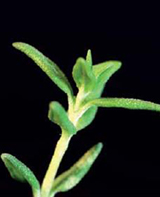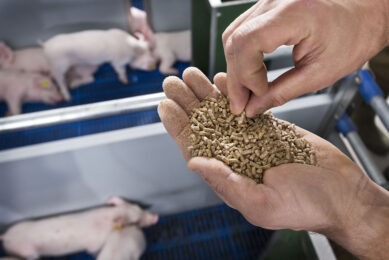Phytogenics: More than sensory additives

Turning phytogenic feed additives into successful products for the animal industry, Austrian company Delacon has been on the market for 25 years. The company shared its experience with 250 delegates during its Performing Nature Symposium in Greece, in November 2009.
By Emmy Koeleman
©
Thyme extracts can be used as a feed additive in pig nutrition.
©
Bioactive molecules derived from nature already have a long history in human medicine. Although these molecules
(also referred to as botanicals, herbs or phytogenics) have a history of medicinal (and human food) use, there is little or no history in animal feed applications. In recent years, the ban of in-feed antibiotics, which was implemented in Europe in January 2006, has driven research activities regarding the potential of plant extracts and essential oils as alternatives to antibiotic growth promoters. The potential benefits such as increased feed intake, stimulation of digestion and improved feed efficiency among others have therefore raised the interest among animal nutritionists. However, it is not only in recent years that there were ideas around phytogenics in animal feed. In 1984, Austrian company Delacon took the first steps of developing phytogenic feed additives. Now, 25 years later and backed up by research papers and trials, phytogenics (plant extracts) are approaching a point where they are a standard ingredient in modern livestock diets, as became clear at the symposium.
©
Mode of action
Prof Dr Wilhelm Windisch from the University of Natural Resources and Applied Life Sciences in Vienna, Austria, gave a clear summary on the current alternatives for antibiotic growth promoters. According to Windisch, essential oils from the labiatae plant family (e.g. thyme and oregano) are widely known to exert antimicrobial effects in vitro and several in vivo studies suggest that their overall impact on gut functions is similar to that of AGPs.
©
“However, we still don’t know exactly if the antimicrobial activity of phytogenics is the real mode of action. Enhanced intestinal mucus production through bitter and/or hot substances is discussed as an alternative mode of action reducing the intestinal pathogen pressure in the animal.”
©
Regarding consumer safety, Windisch said that it needs to be considered that many phytogenic principles are highly absorbable (e.g. essential oils). However, elimination of absorbed phytogenic substances seems to be quite efficient and therefore edible residues do not seem to pose a major concern to consumer safety.
©
Application in pig diets
Ken Purser from Value-Added Science & Technologies (VAST), USA, gave the audience some insight in the use of the product Fresta F in pig diets. In the US, the product is primarily used in weaning diets and diets for lactating sows. Purser explained a large trial that was done to put the phytogenic product to the test. It was shown that pigs with the phytogenic product gained 5.9% faster and 2.6% more efficient than the control pigs. It reduced the number of small pigs at 63 days with 39%.
©
Jorge Marin, head nutritionist from Land O’Lakes in the USA explained the use of a combination of this phytogenic with a hydrating gel for pigs. “Water intake is very important and a reduced water intake leads to less feed intake and reduced performance,” he explained. By providing a combination of a phytogenic product in combination with a gel, you get both the health stimulation effect of the plant extract and the hydrating effect of the gel.
©
Marin explained that this type of product can be beneficial for light, heavy, sick, shipped and vaccinated pigs. Trials that were presented in the presentation showed that the product increased average daily gain (ADG) and feed intake, improved gut health, reduced the pig weight variation and days to market.
©
Effect on immune system
Prof Dr Jürgen Zentek from the Free University in Berlin, Germany gave an overview of the immune system in monogastric animals and the role nutrition can have to boost it. He addressed that the gastro intestinal tract of animal is the biggest immune organ and the barrier to the ‘outer world’. It has the purpose to uptake nutrients but also refuse pathogens from this outer world.
©
“We can steer this to a certain extent by the choice of ingredients in the animal diets,” Zentek said. He specifically mentioned that the weaning period in pigs is a very stressful event, and in turn give a drop in immune responses. Nutritionists should be aware of this, and add specific immune boosting additives at this stage of the production cycle. Examples of these additives are plant extracts and beta-glucans.
©
Stefanie Gärtner, also from Berlin’s Free University, in Berlin presented her PhD-work on the effect of Fresta F on the adhesion of pathogenic E. colito porcine intestinal cells and on immunological parameters in piglets. The results from her in-vitro trials indicate an interference of the phytogenic feed additive with the adhesion of E. coli IPEC-J2 cells, she explained. The feeding trial showed some differences in the immunological traits between the trial and control group. “However, further studies should be done to explain the consequence for animal health,” she added.
©
Phytogenics and the environment
Prof Dr Gerhard Flachowsky highlighted that there is still a lot of work to do before an accurate calculation of the so called ‘carbon footprints’ can be used for regulations or restrictions. He also pointed out that there is also a lot of ‘sun’ in the rumen as undegradeable roughage can be transformed in high quality nutrients, and that this should never be forgotten even if there is the’shadow’ of methane making a big portion of green house gas emissions caused by them.
©
Carlos Piñeiro, PigChamp Pro-Europe, Spain, pointed out some of the remedies to minimise the ammonia output from livestock production. Livestock produces 37% of the total global methane output, 65% of the total global nitrogen oxide and 64% of the total global ammonia output. “As a livestock industry we therefore have to take our responsibility to find solutions to bring these numbers down,” Piñeiro said. As possible solutions, he considered the reduction of crude protein in the diet – reducing 1 point crude protein can lead to an ammonia reduction of 60%, the implementation of phase feeding, the use of specific feed additives such as phytogenics to improve the utilisation of the raw protein and to reduce the urease activity.
©
Source: Pig Progress magazine 25.10
Join 18,000+ subscribers
Subscribe to our newsletter to stay updated about all the need-to-know content in the pigsector, three times a week. Beheer
Beheer










 WP Admin
WP Admin  Bewerk bericht
Bewerk bericht